Leeds Bradford Airport
Leeds Airport redirects here, for the private airport to the East of the city see Leeds East Airport
| Leeds Bradford Airport | |||||||||||
|---|---|---|---|---|---|---|---|---|---|---|---|
 | |||||||||||
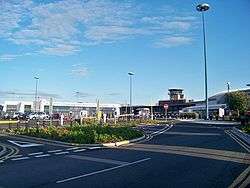 | |||||||||||
| Summary | |||||||||||
| Airport type | Public | ||||||||||
| Owner | Bridgepoint Capital | ||||||||||
| Operator | Leeds Bradford Airport Limited | ||||||||||
| Serves | Leeds and Bradford | ||||||||||
| Location | Yeadon, West Yorkshire, England | ||||||||||
| Elevation AMSL | 681 ft / 208 m | ||||||||||
| Coordinates | 53°51′58″N 001°39′39″W / 53.86611°N 1.66083°WCoordinates: 53°51′58″N 001°39′39″W / 53.86611°N 1.66083°W | ||||||||||
| Website | leedsbradfordairport.co.uk | ||||||||||
| Map | |||||||||||
 EGNM Location in West Yorkshire | |||||||||||
| Runways | |||||||||||
| |||||||||||
| Statistics (2016) | |||||||||||
| |||||||||||
Leeds Bradford Airport (IATA: LBA, ICAO: EGNM) is located at Yeadon, in the City of Leeds Metropolitan District in West Yorkshire, England, 6 nautical miles (11 km; 6.9 mi) northwest of Leeds city centre itself.[1] It was opened in October 1931 as Yeadon Aerodrome,[3] and is still often referred to as Yeadon Airport by locals. It serves the cities of Leeds and Bradford, as well as the wider Yorkshire region including the cities of York and Wakefield, and the District of Harrogate, and is the largest airport within Yorkshire. The airport was in public ownership until May 2007, when it was sold for £145.5 million to Bridgepoint Capital.[4]
Leeds Bradford has a CAA Public Use Aerodrome Licence (Number P800) that allows flights for the public transport of passengers and for flight training. The Airport operates to many domestic and European destinations. The airport is also the highest in England at an elevation of 681 ft (208 m).[5] By the number of passengers handled in 2016, Leeds Bradford was the 15th busiest airport in the UK.[2] It is a base for Jet2.com, Monarch Airlines and Ryanair. Thomson Airways is seasonally based at the airport.
History
Early history
The airport was opened as the "Leeds and Bradford Municipal Aerodrome" (Yeadon Aerodrome) on 17 October 1931[6] and was operated by the Yorkshire Aeroplane Club on behalf of Leeds and Bradford Corporations. In 1935 the aerodrome was expanded by 35 acres (140,000 m2) and scheduled flights began on 8 April 1935 with a service by North Eastern Airways from London (Heston Aerodrome) to Newcastle upon Tyne (Cramlington). The service was soon extended to Edinburgh (Turnhouse). In June 1935 Blackpool and West Coast Air Services started a service to the Isle of Man.[7] By 1936 the London/Yeadon/Newcastle/Edinburgh service was flying three times a week and also stopped at Doncaster and carried on to Aberdeen (Dyce).
Seasonal flights between Yeadon and Liverpool commenced. Work also began on a terminal building, but progress was halted after only one section had been completed.
Wartime use
Civil aviation at Yeadon was halted in 1939, with the outbreak of the Second World War. Avro built a new shadow factory, to produce military aircraft, just to the north of the aerodrome;[8] a taxiway connected the factory to the aerodrome and many of the aircraft first flew from Yeadon.[9] Around 5,515 aircraft were produced and delivered from Yeadon of the following main types: Anson (over 4,500), Bristol Blenheim (250), Lancaster bomber (695), York (45) and the Lincoln (25).[10] the Avro factory was camouflaged and had dummy cows placed on top of the factory so that from the air it would look just like fields with cattle.[9]
Significant improvements were made to the aerodrome; the addition of two runways, taxiways and extra hangarage led to Yeadon becoming an important site for military aircraft test flying.[11]
1947 to 1969
Civil flights recommenced at the airport in 1947,[10] after Geoff Rennard fought for Leeds and Bradford to have an aerodrome, and eventually gained permission for an Aero Club. He was then appointed Airport Manager and stayed at the post for 5 years. Subsequently, Yeadon Aviation Ltd was formed in 1953 to run the Airport and Aero Club. Two years later in 1955 flights to Belfast, Jersey, Ostend, Southend, the Isle of Wight and Düsseldorf were added to Yeadon's destination list.[7] Scheduled flights to London began in 1960, and Dublin was added shortly after. A new runway was opened in 1965, and in that year the terminal building was destroyed by a fire, with a replacement terminal opened by 1968.[6]
1970 to 1994
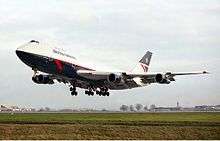
_(2).jpg)
By the mid 1970s the package holiday had become popular in the UK and in 1976 the first holiday charter flight to the Iberian Peninsula departed Leeds Bradford.[12]
In 1978, it was decided that, with runway extensions, the airport could be upgraded to regional airport status. Work began in 1982, and was completed in November 1984. This included a significant extension to the main runway, including the construction of a tunnel to take the A658 Bradford to Harrogate road beneath the runway.[13] The airport also underwent significant extensions and redevelopments to the Terminal building, the first phase of which was opened on 18 July 1985.[14]
On 4 November 1984, the day the runway extension was officially opened, Wardair commenced transatlantic flights from Leeds Bradford to Toronto, using Boeing 747s, though these flights were later discontinued.[15]
On 2 August 1986, an Air France Concorde charter flight from Paris landed at Leeds Bradford for the first time, and an estimated 70,000 people were there to see it.[16] Occasional Concorde charter flights, all of which used British Airways aircraft, continued until June 2000, just one month before the Concorde disaster in Paris.
Initially the airport had restricted operating hours, and this deterred many charter airlines, whose cheap fares depended on 'round-the-clock' use of their aircraft. In 1994, these restrictions were removed and flights could use the airport 24 hours a day,[17] so more airlines were attracted to Leeds Bradford.
1995 to date
Work on the airport terminal has been ongoing since 1996, and the result of this has been significant growth in terminal size and passenger facilities. In 2007 nearly 2.9 million passengers passed through the airport, an 88% increase in just seven years and more than twice as many compared with 1997 (1.2 million). Much of the growth in passenger numbers since 2003 has been due to the introduction of scheduled flights by the based low-cost airline Jet2.com.
Between 2000 and 2013, the airport was home to the West/South air platform of the Yorkshire Air Ambulance. It moved to Nostell in November 2013.[18][19]
The original runway (09/27) was closed on 6 October 2005, to be redeveloped as a taxiway and to provide additional apron space. In November 2008 the early stages of the airport masterplan were clarified, with in-depth detailed plans for the expansion of the airport terminal being published, at an estimated cost of £28 million.
Current facilities
The airport has one terminal. It has two airbridges, but is currently stated in the masterplan that 4 more jetbridges will be added along with terminal enlargement and development. It has 24 aircraft stands capable of handling aircraft up to Boeing 777 aircraft but could be increased to 32 in future plans. The terminal consists of two check-in halls: Check in hall A is used by all airlines except Jet2; the other is solely used and operated by Jet2. It has a large security facility run by the airport staff as well as West Yorkshire police. Upstairs there is a retail space which comprises shops, restaurants, bars and a duty-free area. There is a premier lounge located near the departure area. There are long and short-stay car parks with over 2000 parking spaces as well as a drop off points.
RAF Yeadon
| Royal Air Force Station Yeadon | |
|---|---|
| Type | Military airfield |
| Site information | |
| Controlled by | Royal Air Force |
| Site history | |
| Built | 1931 |
| In use | 1936-1939, 1946-1957 |
| Garrison information | |
| Garrison | RAF Fighter Command |
609 (West Riding) Squadron was based here from its formation on 10 February 1936[20] until 27 August 1939 when they moved to Catterick[21] (not returning again until 1947). 609 reformed in 1946 and returned to Yeadon in 1947[22] with their Mosquito MK.XXX aircraft, which proved difficult due to the runways being too short to comfortably operate these aircraft. Safety speed (that which the aircraft needs to be flown and controlled on a single engine) was not reached until over flying central Leeds if taking off in that direction—with obviously drastic results should things go wrong on take-off. In addition, the airfield sloped downhill, meaning that it was necessary to land at RAF Linton-on-Ouse (20 miles away) if the wind was coming from the wrong direction.[23] Eventually the Air Ministry re-equipped 609 with Spitfire LFXVIs.[23] This was sufficient as a short-term measure, but the grass airstrip was not ideally suited to Spitfire operations, and so it was decided that 609 Squadron should move to the hard runways of RAF Church Fenton in October 1950.[24]
Yeadon was requisitioned by the Royal Air Force and became part of firstly 13 Group, then 12 Group at a later date. Once 609 (West Riding) Squadron left for Catterick, Yeadon served as a Flying Training School, bomber maintenance unit, and a scatter airfield. In January 1942 it was transferred to the Ministry of Aircraft Production, whereupon Avro built a shadow factory for the production of Albermarles, Ansons, Lancasters, Yorks, and Lincolns. It was also used by Hawker Aircraft for development work on its Tornado design. The Royal Air Force remained a part of Yeadons life until 1957, operating Austers, Supermarine Spitfires, De Havilland Mosquitoes out of here. RAF Yeadon finally closed in 1959.[25]
- 609 (West Riding) Squadron 1936-1939, 1946–1950
- 23 Gliding School 1946-1950
- Leeds University Air Squadron 1955-1960
- 1970 Flight 1952-1957
Aircraft that would have been based at Yeadon.
- Hawker Hart 1936-1938
- Hawker Hind 1938-1939
- Supermarine Spitfire 1946
- De Havilland Mosquito 1946-1948
- Slingsby Cadet TX.1 1946-1950
- Slingsby Grunau Baby 1947-1950
- De Havilland Canada Chipmunk 1955-1960
- Auster 1952-1957[26]
Future

In line with government recommendations, Leeds Bradford Airport published a masterplan. However, since then the airport has been privatised and the new plans of Bridgepoint Capital deviate in areas from the masterplan. The plans that Bridgepoint Capital published were approved by Leeds City Council in July 2009, despite much criticism from protesters. The plans were originally rejected by Leeds City Council on the grounds of further traffic generated from an enlarged airport. The revised plans included the provision of further bus services, however no commitment was made to invest in a rail or light rail link, although the plan continues to be considered. Incidentally, neither the previously proposed Leeds Supertram or the currently proposed Leeds Trolleybus go to Leeds Bradford International Airport, although each would have a terminus a few miles away at Bodington Hall, Lawnswood.
The Masterplan
In 2004 the airport published a master plan in line with government recommendations. The master plan set out the following proposals for future development:[27][28][29]
- Expansion of the terminal buildings, with new gates added including airbridge boarding tunnels.
- New aircraft parking areas (there are currently 24 stands, this would increase to 31).
- A change to the runway configuration (part of which has already been carried out). This includes building a taxiway parallel to the main runway. This would allow aircraft movements to increase from 26 to 34 per hour.
- New airfield equipment and buildings (including aircraft hangars, new flight catering facilities and a new fuel farm).
- Hotel and office space (the first phase of which is now complete).
- A railway station from a spur near Horsforth.
- New car parking areas.
- A new link road from the A65, to the airport and then to the A658.
The master plan sets out the stages of development for Leeds Bradford Airport over the next 10 years and outlines general proposals for the period from 2016 to 2030. It is estimated that by 2016 the airport will handle in excess of 5.1 million passengers per year as well as seeing a significant increase in freight traffic. Both Flybe and Ryanair have expressed an interest in expanding their routes at the airport, with Ryanair announcing intentions to base aircraft there.[30] By 2010 Ryanair had made good this pledge and had Boeing 737-800 aircraft based at the airport operating new routes.[31]
Bridgepoint Capital and Leeds City Council hope that by redeveloping the airport, it will attract even more companies, jobs and people to the area which already has a population of 2.9 million.[27]
Bridgepoint Capital development plan of 2008
On 4 November 2008, Bridgepoint Capital announced their £28 million plans to redevelop the airport terminal.[32] Planning permission was submitted to Leeds City Council in late November 2008. The plans involve building in front of the current terminal building, effectively turning the current crescent-shaped building into a semicircle. As the current terminal buildings are the product of 40 years of extensions, there is no continuity to the layout and the buildings can become very congested. The extension would be set over two stories and would facilitate new departure and arrival facilities. The ground floor will house new check-in halls, while on the first floor there will be a large departure lounge, featuring a glass roof.[32] Both arrival and departure facilities will benefit from new retail facilities as the management claimed that current facilities were 'inadequate and unenticing'. It is estimated that with the completion of the airport extension and the forecast new flights, an extra 2,000 jobs will be generated at the airport.[33] Since 2008 the redevelopment plans have remained largely unchanged, however the proposed external appearance of the building has changed, being clad in black instead of the white cladding that had initially been proposed.[34]
Completed developments since 2010
Since 2010 the airport terminal has been remodeled with adoption of a more conventional layout with arrivals on the ground floor (with the exception of passport control) and departures on the first floor (with the exception of both check-in halls, security and gates 1-5 which are served by a sports bar, Camden Food Company and a WH Smiths, also on the ground floor. The first floor area encompassing Burger King has been moved from land-side to air-side. A new shopping and dining area has been created on the first floor. New self-park car parking areas have been built to the North East of the site and are linked to the terminal by shuttle buses.
Airport ownership
Leeds and Bradford councils jointly bought the airport site at Yeadon in 1930,[35] which opened as Yeadon Aerodrome in 1931. The airport became a limited company in 1987, and was shared between the five surrounding boroughs of Leeds (40%), Bradford (40%) and Wakefield, Calderdale and Kirklees (together sharing the remaining 20%).
In October 2006 plans to privatise the airport were confirmed when Bradford Council became the last of the five controlling councils to agree to sell off the airport to the private sector. On 4 April 2007 the five controlling councils announced that Bridgepoint Capital had been selected as the preferred bidder.[36] On 3 May 2007 Bridgepoint was confirmed as the buyer.[37] On 4 May 2007 Bridgepoint Capital acquired the airport from Leeds, Bradford, Wakefield, Calderdale and Kirklees councils for £145.5 million. Although Bridgepoint Capital own the airport 100% financially, the councils hold a "special share" in the airport, to protect its name and continued operation as an air transport gateway for the Yorkshire region. The new owners said they were to implement a £70 million capital expenditure plan, to focus on improving passenger and retail infrastructure in order to increase passenger capacity to 7 million per annum by 2015.[4]
Airlines and destinations
The following airlines operate regular scheduled and charter flights to and from Leeds/Bradford:[38]
Statistics
Passengers and movements
| Number of Passengers[43] | Air Transport Movements[44] | Leeds Bradford Airport Passenger Totals 1997-2016 (millions) | ||
|---|---|---|---|---|
| 1997 | 1,254,853 | 26,123 | 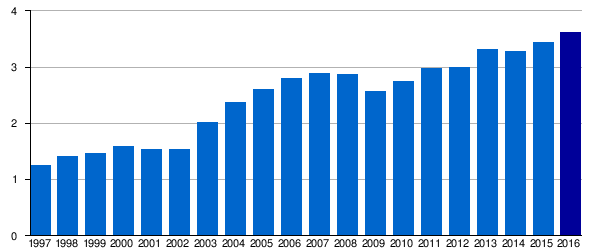 | |
| 1998 | 1,406,948 | 25,615 | ||
| 1999 | 1,462,497 | 26,185 | ||
| 2000 | 1,585,039 | 29,263 | ||
| 2001 | 1,530,227 | 28,397 | ||
| 2002 | 1,530,019 | 28,566 | ||
| 2003 | 2,017,649 | 29,397 | ||
| 2004 | 2,368,604 | 31,493 | ||
| 2005 | 2,609,638 | 35,949 | ||
| 2006 | 2,792,686 | 37,251 | ||
| 2007 | 2,881,539 | 39,603 | ||
| 2008 | 2,873,321 | 37,604 | ||
| 2009 | 2,574,426 | 32,531 | ||
| 2010 | 2,755,110 | 33,911 | ||
| 2011 | 2,976,881 | 33,069 | ||
| 2012 | 2,990,517 | 30,223 | ||
| 2013 | 3,318,358 | 31,057 | ||
| 2014 | 3,274,474 | 30,663 | ||
| 2015 | 3,445,302 | 31,149 | ||
| 2016 | 3,612,117 | 32,196 | ||
| Source: UK Civil Aviation Authority[2] | ||||
Routes
| Rank | Airport | Total passengers | Change 2015 / 16 |
|---|---|---|---|
| 1 | Alicante | 311,650 | |
| 2 | Dublin | 294,014 | |
| 3 | Málaga | 276,999 | |
| 4 | Palma de Mallorca | 256,359 | |
| 5 | Amsterdam | 253,757 | |
| 6 | Faro | 204,802 | |
| 7 | Tenerife–South | 180,525 | |
| 8 | London–Heathrow | 160,703 | |
| 9 | Belfast–City | 159,107 | |
| 10 | Lanzarote | 113,188 | |
| 11 | Barcelona | 90,035 | |
| 12 | Ibiza | 80,076 | |
| 13 | Gdańsk | 67,486 | |
| 14 | Fuerteventura | 60,564 | |
| 15 | Kraków | 58,652 | |
| 16 | Menorca | 50,374 | |
| 17 | Murcia | 49,738 | |
| 18 | Düsseldorf | 49,150 | |
| 19 | Paris–Charles de Gaulle | 46,604 | |
| 20 | Dalaman | 44,166 |
Other facilities
_003.jpg)
Jet2.com's head office is located in the Low Fare Finder House,[46] a building on the grounds of Leeds Bradford Airport. As of 2006 the facility was under construction, meant to accommodate pilots, cabin crew, and "behind the scenes" employees.[47] Jet2.com's parent company, Dart Group, has its head office in the same building.[48] West Yorkshire metropolitan police are based at the airport by security. There is a large police presence at the airport, and following the 2016 Brussels bombings, the police are often armed with firearms.
Ground transport
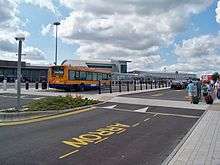
Bus services that link the airport include the 757 route to Leeds operated by Yorkshire Tiger which runs every 20 minutes. Routes 737 and 747, also operated by Yorkshire Tiger, run to Bradford Interchange, and the 747 route extends to Harrogate. Transdev Keighley operates route 967 to Menston railway station. A service is planned to be restarted to York in the near future. Services to Leeds and Bradford link the airport with the National Rail network via Leeds railway station, Bradford Interchange and Bradford Forster Square and connects with long distance coach services at Leeds City bus station and Bradford Interchange.
As part of both the airport and Metro's long-term strategies, there are proposals for the construction of a direct rail link to the airport on a branch from the Harrogate Line, however no firm commitments or timescales have been announced.[27] Leeds North West MP Greg Mulholland has consistently campaigned for the construction of a rail link, having his case heard by transport minister Susan Kramer in March 2015.[49] As of now, the two nearest railway stations are Guiseley and Horsforth. There is a direct link by the 737 Bradford–Airport bus from the airport to Guiseley, and service 757 between Leeds and the Airport provides a service between the Airport and New Road side in Horsforth where connections exist with service(s) 31 and 32 to Horsforth railway station Monday to Saturday during daytime.
The airport has connections to the local road network and is signposted on a large number of routes in the region. For arriving passengers, there is no longer a taxi rank as such, although the airport management has been urged by Leeds City Council to reinstate it. Instead, a single taxi company has an office just outside the main terminal, where passengers can book and pay for their taxi in advance. Alternatively, these taxis can be booked in advance online or by telephone. Departing passengers brought by other taxi companies have the alternative of paying an additional £3 for the drop-off fee outside the terminal, or being dropped off at a nearby roundabout.[50]
The airport charges a parking fee for cars that are dropping off and picking up passengers momentarily at the terminal front.[51] There is however free drop off and pick up parking [52] provision available for up to an hour in long stay car parks with a 5-minute walk to the terminal building[53]
Flight training and general aviation
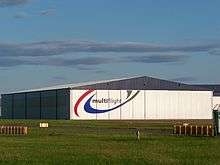
The airport is home to Multiflight, a flight training and aircraft engineering organisation. They are also the dedicated FBO at the airfield and provide helicopter and fixed wing charter flights as well as aircraft sales and management. General aviation operations are confined to the south-side of the airport, in order to maintain separation from commercial traffic utilising the main terminal.
In addition to numerous privately owned aircraft hangared on the south-side, a fleet of around 18 training aircraft are based at the airport. These include Cessna 152s, Piper PA28s and Beechcraft BE-76 Duchess twin engine trainers and Robinson R22 and R44 helicopters.
During 2005 two new hangars capable of housing 4 × B737-800s were constructed, as well as a new apron and direct taxiway to the runway. A dedicated southside fuel farm was also installed.[54] In the past decade, over £10m has been invested into infrastructure on the south side by Multiflight.
The Aviation Academy is also located in a hangar at Leeds Bradford Airport, in conjunction with the Open University. Aviation professionals Derek Brickell and Peter Jackson, are based at the academy. The academy trains and prepares students to work in the aviation industry.
Incidents and accidents
Prior to 1985, there were two recorded incidents of runway overruns at Leeds Bradford Airport, both involving British Midland Airways Viscount aircraft, and both showing evidence of hydroplaning.[55]
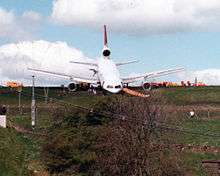
- On 27 May 1985, a Lockheed Tristar operated by British Airtours, registration G-BBAI, overran the runway surface on landing from Palma after a rain shower. The aircraft was evacuated, with only minor injuries sustained by the 14 crew and 398 passengers. The nose landing gear strut folded backwards during the overrun, leading to severe damage to the underside of the forward fuselage. The undersides of both wing-mounted engines were flattened and both engines suffered ingestion damage. The main wheels of the aircraft also dug deep troughs in the area beyond the end of the runway, damaging the buried airfield lighting cables. The accident report concluded that the overrun was caused by the inability of the aircraft to achieve the appropriate level of braking effectiveness and recommended that both the scheduled wet runway performance of the TriStar and the condition of the surface of runway 14 at Leeds Bradford Airport should be re-examined.[55][56]
- On 24 May 1995, an Embraer EMB 110 Bandeirante aircraft, registration G-OEAA operated by Knight Air on a flight between Leeds Bradford and Aberdeen (see Knight Air Flight 816) entered a steeply descending spiral dive, broke up in flight and crashed into farmland at Dunkeswick Moor near Leeds. All 12 occupants were killed. The probable cause of the accident was the failure of one or both artificial horizon instruments. There was no standby artificial horizon installed (as there was no airworthiness requirement for one on this aircraft) and the accident report concluded that this left the crew without a single instrument available for assured attitude reference or simple means of determining which flight instruments had failed. The aircraft entered a spiral dive from which the pilot, who was likely to have become spatially disoriented, was unable to recover.[57][58]
- On 18 May 2005, a Jordanian Airbus A320, registration JY-JAR operating for Spanish charter airline LTE suffered a braking malfunction on landing at Leeds Bradford Airport following a flight from Fuerteventura. The aircraft touched down on runway 14 just beyond the touchdown zone, approximately 400 m (1,300 ft) beyond the aiming point. The pilots determined that the rate of deceleration was inadequate and applied full reverse thrust and full manual braking in an effort to stop the aircraft, however the normal braking system malfunctioned and the Captain turned the aircraft onto a level grassed area to the right of the runway where it came to rest. There were no injuries to the passengers or crew, however the Air Accidents Investigation Branch made seven safety recommendations in the final accident report.[59][60]
See also
References
- 1 2 "Leeds Bradford - EGNM". Nats-uk.ead-it.com. Retrieved 5 June 2014.
- 1 2 3 "UK Airport Data". UK Civil Aviation Authority. 3 March 2017. Retrieved 15 March 2017.
- ↑ "History & Developments". Leeds Bradford Airport Company. Retrieved 10 December 2010.
- 1 2 "Bridgepoint acquires Leeds Bradford International Airport". LBIA. 3 May 2007. Archived from the original on 12 May 2007. Retrieved 8 December 2015.
- ↑ Leeds Bradford International Airport - Airfield Information
- 1 2 "History of Leeds Bradford Airport". Leeds Bradford Airport Arrivals. Retrieved 18 February 2016.
- 1 2 "History of Leeds Bradford Airport". Leeds Airport Guide. Retrieved 18 February 2016.
- ↑ "Yeadon Conservation Area" (PDF). Leeds City Council. 16 January 2012. p. 7. Retrieved 18 February 2016.
- 1 2 "Yeadon". Avro Heritage Museum. Retrieved 18 February 2016.
- 1 2 "Leeds Bradford Airport History". on Yorkshire Magazine. 20 September 2012. Retrieved 18 February 2016.
- ↑ "Leeds Bradford Airport Masterplan 2005 - 2016" (PDF). lbia. p. 11. Retrieved 18 February 2016.
- ↑ Phillips, Allan (2012). Leeds Bradford Airport Through Time. Amberley. p. 62. ISBN 9781445606095. Retrieved 17 February 2016.
- ↑ Bond, Chris (18 September 2011). "Aerodrome that became Yorkshire’s gateway to the world". Yorkshire Post. Retrieved 18 February 2016.
- ↑ Phillips, Allan (2012). Leeds Bradford Airport Through Time. Amberley. p. 70. ISBN 9781445606095. Retrieved 17 February 2016.
- ↑ Phillips, Allan (2012). Leeds Bradford Airport Through Time. Amberley. p. 71. ISBN 9781445606095. Retrieved 17 February 2016.
- ↑ Bradshaw, Simon; Alred, Don (4 August 1986). "Vive La Concorde!". Telegraph and Argus. Retrieved 17 February 2016.
- ↑ LBIA - History & Developments Archived 17 April 2007 at the Wayback Machine.
- ↑ "Nostell Air Support Unit". Yorkshire air ambulance. Retrieved 17 February 2016.
- ↑ "Yorkshire Air Ambulance to operate from new base from next summer". Yorkshire Post. 16 October 2012. Retrieved 17 February 2016.
- ↑ "609 Sqn". Royal Air Force. RAF. Retrieved 18 February 2016.
- ↑ Phillips, Alan (2012). Leeds Bradford Airport Through Time. Stroud: Amberley. p. 23. ISBN 9781445606095.
- ↑ Ziegler, Frank (1971). The Story of 609 Squadron - under the White Rose. London: MacDonald. p. 8. ISBN 0356036413.
- 1 2 Ziegler, Frank (1971). The Story of 609 Squadron - under the White Rose. London: MacDonald. p. 321. ISBN 0356036413.
- ↑ Ziegler, Frank (1971). The story of 609 Squadron - under the White Rose. London: MacDonald. pp. 323–324. ISBN 0356036413.
- ↑ Phillips, Alan (2013). Leeds Bradford Airport through time. Stroud: Amberley. pp. 79–87. ISBN 9781445606095.
- ↑ "609 Squadron". WW II RAF living History Group. Retrieved 19 March 2016.
- 1 2 3 LBIA Master Plan 2005-2016 Archived 27 February 2009 at the Wayback Machine.
- ↑ LBIA - Airport Masterplan Archived 17 October 2008 at the Wayback Machine.
- ↑ Leeds Bradford International Airport, Masterplan 2005-2016 Summary Archived 20 November 2008 at the Wayback Machine.
- ↑ "Flybe's pledge to airport". Yorkshire Post. 9 September 2008. Retrieved 5 June 2014.
- ↑ "Jobs boost as Ryanair announces new Leeds Bradford Airport base". Yorkshire Evening Post. 11 August 2009. Retrieved 16 February 2016.
- 1 2 "Airport reveals £28m revamp plan". BBC News. 4 November 2008. Retrieved 19 February 2016.
- ↑ "£28m Leeds Bradford airport plan ready for take-off". Yorkshire Evening Post. 4 November 2008. Retrieved 5 June 2014.
- ↑ Archived 24 September 2010 at the Wayback Machine.
- ↑ Firth, Gary (1997). A History of Bradford. Phillimore. ISBN 1-86077-057-6.
- ↑ LBIA - Preferred Bidder Press Release Archived 27 September 2007 at the Wayback Machine.
- ↑ "Airport Sold For 145 Million To Bridgepoint". Bradford Telegraph and Argus. 3 May 2007. Retrieved 5 June 2014.
- ↑ leedsbradfordairport.co.uk - Our destinations retrieved 23 November 2016
- ↑ Flybe announces new route to Dusseldorf from Leeds Bradford Airport. Press Release Leeds Bradford Airport. 1 June 2017
- 1 2 http://www.bbc.co.uk/news/uk-scotland-highlands-islands-38055208
- ↑ http://www.routesonline.com/news/38/airlineroute/271685/ryanair-w17-new-routes-as-of-05mar17/
- ↑ http://www.routesonline.com/news/38/airlineroute/271016/thomson-outlines-planned-new-routes-in-s17/
- ↑ Number of Passengers including both domestic and international.
- ↑ Represents total air transport takeoffs and landings during that year.
- ↑ "Airport Data 2016". UK Civil Aviation Authority. 3 March 2017. Tables 12.1(XLS) and 12.2 (XLS). Retrieved 16 March 2017.
- ↑ "Jet2.com Terms Of Use." Jet2.com. Retrieved on 31 December 2011. "Registered office: Low Fare Finder House, Leeds Bradford Airport, Leeds, LS19 7TU."
- ↑ "Jet2.com builds on its foundations at Leeds Bradford - literally!" Jet2. 6 February 2006. Retrieved on 19 June 2010.
- ↑ "Contacts." Dart Group. Retrieved on 31 December 2011. "Registered Office Dart Group PLC Low Fare Finder House Leeds Bradford International Airport Leeds LS19 7TU United Kingdom"
- ↑ McIntyre, Annette (6 March 2015). "Schools Awards 2016 Transport minister hears of need for rail link on airport visit". Telegraph and Argus. Retrieved 17 March 2016.
- ↑ "Leeds Bradford Airport proposing free drop-off area". Bradford Telegraph and Argus. 12 June 2012. Retrieved 5 June 2014.
- ↑ "UK Airport Charges". APH.com. Retrieved 5 June 2014.
- ↑ "UK Airport Chauffeur Parking Charges". manchesterchauffeurparking.co.uk. Retrieved 12 August 2014.
- ↑ "Terminal Front Express Parking". Leedsbradfordairport.co.uk. 30 August 2010. Retrieved 5 June 2014.
- ↑ "Leeds Bradford Airport Masterplan 2005 - 2016" (PDF). lbia. p. 31. Retrieved 18 February 2016.
- 1 2 "Lockheed TriStar, G-BBAI". UK AAIB. Retrieved 7 February 2008.
- ↑ "Picture Lockheed TriStar, G-BBAI".
- ↑ "AAIB Report No: 2/1996". UK AAIB. Retrieved 5 March 2008.
- ↑ "EMB-110, G-OEAA". Aviation Safety Network. Retrieved 13 December 2007.
- ↑ "Airbus A320-211, JY-JAR". UK AAIB. Retrieved 13 December 2007.
- ↑ "Picture Airbus A320-211, JY-JAR".
Further reading
- Aircraft in British Military Service: British Service Aircraft Since 1946 (ISBN 1 85310 891 X), Airlife Publishing, First Published-1998
External links
![]() Media related to Leeds Bradford International Airport at Wikimedia Commons
Media related to Leeds Bradford International Airport at Wikimedia Commons